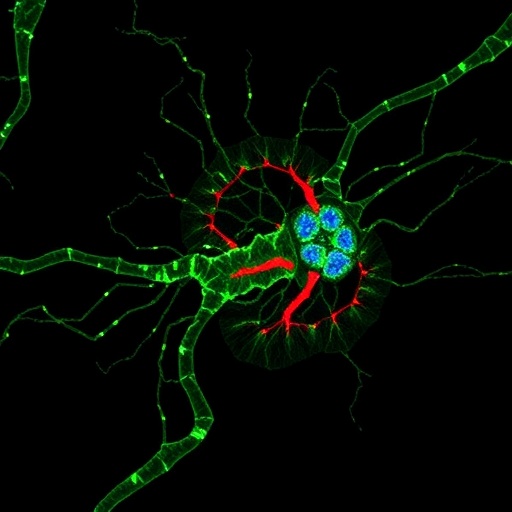In the ever-evolving landscape of cancer biology, recent discoveries continue to unravel the complex molecular circuits driving tumor development and progression. A groundbreaking study published in Nature Communications this year sheds light on the intricate interplay between transcriptional regulators and mTOR signaling pathways in the context of renal tumorigenesis. Researchers led by Kshitij Asrani and colleagues have uncovered the pivotal role of the SFPQ-TFE3 fusion protein in orchestrating both mTORC1 activity and cellular plasticity within a mouse model of kidney cancer, findings that herald a new frontier for understanding tumor heterogeneity and therapeutic resistance.
The study centers on the TFE3 transcription factor, a member of the MiT/TFE family, whose aberrant activation via chromosomal translocations is a hallmark of certain renal cancers. These gene fusions are well-known to alter cellular behavior, but their downstream signaling consequences have remained incompletely characterized. The team identified that the fusion of TFE3 with SFPQ, a splicing factor, produces a chimeric protein that exerts reciprocal control over the mechanistic target of rapamycin complex 1 (mTORC1), a master regulator of cell growth and metabolism intimately linked to oncogenesis.
Through meticulous molecular dissection, the researchers demonstrated that the SFPQ-TFE3 fusion acts as a dual modulator: it suppresses mTORC1 activation while simultaneously promoting lineage plasticity, a phenomenon where cells adopt alternative differentiation states. This plasticity provides tumor cells a survival advantage, enabling them to adapt to environmental stresses and evade standard therapeutic interventions. Such flexibility is increasingly recognized as a critical factor in tumor evolution and drug resistance, making the elucidation of its molecular triggers invaluable.
Employing a genetically engineered mouse model that recapitulates the human renal tumorigenic process, the investigators observed that expression of SFPQ-TFE3 induces a drastic shift in tumor cell identity. This shift involves a rewiring of transcriptional networks that balance proliferative signaling and differentiation cues. The resultant tumors exhibit heterogeneous cellular populations, which complicate treatment but also reveal potential vulnerabilities linked to the molecular axis controlled by the fusion protein.
Central to the mechanism is the antagonistic regulation of mTORC1, a signaling hub integrating nutrient and growth factor inputs to coordinate anabolic processes. Typically, mTORC1 activation promotes cell proliferation and survival, crucial during tumor expansion. However, the SFPQ-TFE3 fusion subverts this paradigm by attenuating mTORC1 signaling, thus curbing unchecked growth yet paradoxically enabling the cells to transition into varied lineage states. This nuanced manipulation underscores the complexity of oncogenic pathways and highlights the fact that tumors do not merely ramp up growth signals but also recalibrate them to foster adaptability.
The authors employed advanced transcriptomic and proteomic analyses to delineate how SFPQ-TFE3 exerts its regulatory influence. Their data revealed changes in downstream effectors that modulate autophagy and metabolism, processes closely tied to mTOR function. This finding suggests that targeting the fusion protein or its effectors could restore mTORC1 activity balance and consequently impair tumor plasticity, offering a strategic point of intervention.
Notably, the reciprocal regulation discovered in this study challenges previously simplistic views of mTORC1 as merely a growth-promoting entity in cancer. Instead, it supports a model where precise temporal and spatial tuning of mTORC1 activity can switch cellular programs on or off, driving phenotypic diversity within tumors. This advances our understanding of tumor microenvironmental adaptations and the emergence of resistant clones during therapy.
Beyond the mechanistic insights, the research highlights the translational potential of modulating the SFPQ-TFE3 fusion-driven pathways. By elucidating the molecular cascades involved, the study opens avenues to develop targeted therapies that disrupt the fusion protein’s function or restore mTORC1 signaling homeostasis. Such approaches may prevent or reverse lineage plasticity, potentially enhancing the efficacy of existing treatments and improving patient outcomes in renal cell carcinoma.
The reciprocal interplay between SFPQ-TFE3 and mTORC1 might also serve as a biomarker axis to stratify patients more likely to benefit from mTOR inhibitors or combination therapies addressing phenotypic plasticity. Precision oncology increasingly demands such biomarkers to tailor treatments, and the identification of this fusion-dependent regulatory circuit enriches the diagnostic toolkit for clinicians confronting aggressive kidney cancers.
Further, the study underscores the important role of transcription factors and splicing regulators in the modulation of canonical signaling pathways. It reveals that fusion proteins can orchestrate complex cellular phenotypes not only by directly regulating gene expression but also by fine-tuning key metabolic and growth pathways, expanding the paradigm of oncogenic driver functions.
These findings prompt a reevaluation of the therapeutic landscape for TFE3-fusion positive renal cell carcinoma and potentially other cancers harboring similar molecular rearrangements. Targeting lineage plasticity and mTOR signaling axes concurrently might represent a novel combinatorial strategy, with the potential to overcome intrinsic tumor heterogeneity and adaptive resistance.
The innovative use of a mouse model mimicking human disease settings increases the confidence in the clinical relevance of these discoveries. By closely mirroring tumor progression and microenvironmental dynamics, this approach provides a robust platform for preclinical testing of drugs that modulate the SFPQ-TFE3-mTORC1 nexus, accelerating bench-to-bedside translation.
While the complex biology unraveled here highlights the challenges faced in targeting dynamic tumor states, it also instills optimism that deep molecular characterization of oncogenic fusions can yield actionable insights. Continual exploration of fusion protein biology promises to refine cancer taxonomy and enrich therapeutic decision-making frameworks.
In a broader context, these results intersect with emerging concepts in cancer biology emphasizing plasticity not merely as a byproduct of genetic mutation but as a sculpted, regulated feature instrumental for tumor survival. Unraveling the multilayered regulation of pathways like mTOR by fusion proteins thus represents a critical step in decoding how cancers co-opt cellular machinery to thrive under selective pressures.
As precision medicine advances, the work of Asrani et al. stands as a testament to the power of integrative molecular approaches in exposing vulnerabilities hidden within oncogenic fusions. Their elucidation of the SFPQ-TFE3 fusion’s bidirectional governance over mTORC1 and lineage states sets the stage for innovative therapeutic targeting, promising a leap forward in the management of renal tumorigenesis.
The detailed mechanistic insights also provoke intriguing questions for future research, including how environmental cues influence SFPQ-TFE3 activity and whether analogous regulatory fusions exist in other malignancies. Addressing these queries could accelerate the development of pan-cancer strategies aimed at transcription factor fusion proteins and their associated signaling pathways.
Ultimately, this study exemplifies the convergence of genomics, molecular biology, and in vivo modeling in forging new understandings of cancer pathobiology. It underscores the potential for fusion oncoproteins not just as markers of disease but as architects of adaptive tumor behavior, redefining targets for intervention in the fight against kidney cancer and beyond.
Subject of Research: Molecular mechanisms of SFPQ-TFE3 fusion protein in regulating mTORC1 signaling and lineage plasticity in renal tumorigenesis.
Article Title: SFPQ-TFE3 reciprocally regulates mTORC1 and induces lineage plasticity in a mouse model of renal tumorigenesis.
Article References:
Asrani, K., Amaral, A., Woo, J. et al. SFPQ-TFE3 reciprocally regulates mTORC1 and induces lineage plasticity in a mouse model of renal tumorigenesis. Nat Commun 16, 8822 (2025). https://doi.org/10.1038/s41467-025-63885-2
Image Credits: AI Generated





